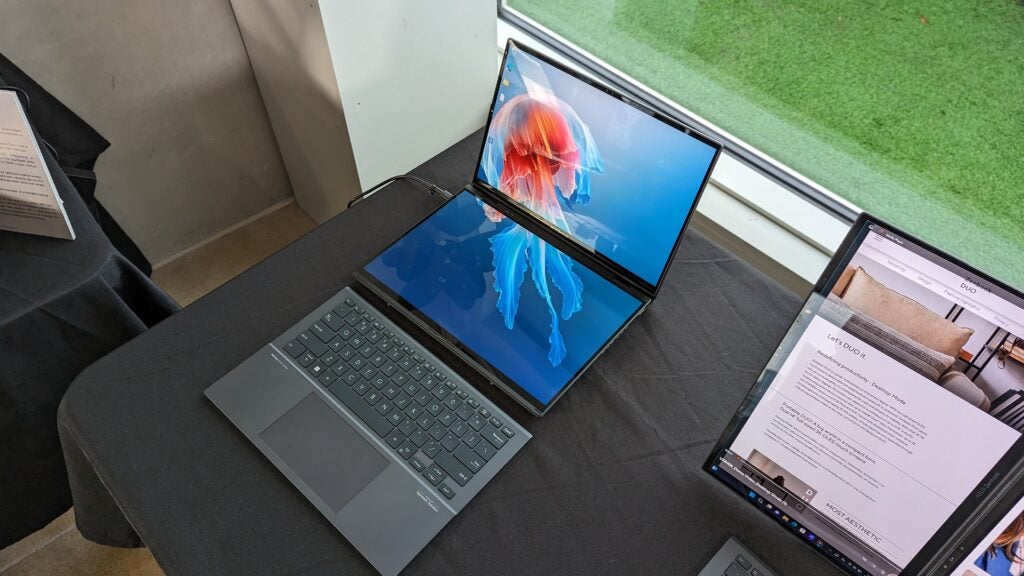Apparently, foldable displays aren’t quite the be-all and end-all when it comes to the future of technology, with Asus now joining Lenovo in innovating with a slightly tamer dual-screen form factor. The Asus Zenbook Duo (2024) is here, and this is how it compares with the second-generation Lenovo Yoga Book 9i.
Last year, Lenovo released a new design that was a departure from the newfangled laptops with a foldable display that had also recently launched. It offers similar functionality and benefits, just without the complexities of a huge foldable panel to navigate. In 2024, it’s updating the device with Intel’s new chips but it has a new fierce challenger to take on.
Like with the Asus Zenbook 17 Fold OLED and the Lenovo ThinkPad X1 Fold, Asus is arriving slightly later to the party than Lenovo. But, with the new Zenbook Duo, Asus is offering quite a different proposition to its Lenovo rival that looks to undercut it in many ways. Let’s get into it.
The Zenbook Duo is much cheaper
Right off the bat, the new Asus Zenbook Duo (2024) has a key upper hand on its Lenovo rival. The Zenbook Duo comes in at a price of £1,699/$1,499 versus the significantly higher cost of the $1,999.99 Lenovo Yoga Book 9i (2024). We’ll get into specifications in more detail at another point but the Asus not only offers a lower starting price but can be specced up to a more performant Intel chip and offers larger displays.
It still doesn’t make the Asus a cheap laptop but it is more palatably priced up against other modern laptops with a dose of innovation built-in, while the Lenovo feels like it’s in a price bracket above.

The Lenovo Yoga Book 9i has a more luxurious look
Despite the lower cost of the Asus, Lenovo can offer an immediate response to that. One of the most impressive aspects of the Yoga Book 9i is that, when closed, it looks exactly like a typical high-end Lenovo Yoga device and far from some prototype. From our experience with the previous model, we can say it’s a stylish and durable design. The Lenovo does also offer a 360-degree hinge, while the Asus is limited to 180-degree. But, given these devices are rather hefty for tablet-like use and tent mode is of limited use, it isn’t a huge point of differentiation.
But, unlike the Asus Zenbook 17 Fold OLED, the new Zenbook Duo does look more accomplished in its own right, dodging the concept-like look of its foldable display stablemate.

The Asus gives you a trackpad, a full-size keyboard and a built-in stand
When we received the original Lenovo Yoga Book 9i, despite being wooed by its multi-tasking-friendly dual-screen setup, a key bugbear remained and it’ll still be around for the new model. There is no physical trackpad as part of the attachment, instead, you just get a keyboard. That means you either have to carry around Lenovo’s additional mouse accessory, use your own or, god forbid, use the onscreen trackpad.
Asus has tackled this issue by making its attachment simply represent the traditional bottom half of a laptop, meaning you get a full-size laptop keyboard and a trackpad. It just makes so much sense and Lenovo should follow suit next time around. Further, the Yoga Book 9i also comes with a separate stand to carry around while the Asus has one handily built-in.

Apple TV+
The Home of Apple Originals. Enjoy star-studded, award-winning series, films, and more. Grab your 7 day free trial now.
- Apple
- 7 day free trial
- £6.99 p/m
Asus has the upper hand on most key specifications
Despite its lower starting price, Asus offers a lot of better configuration options. You’ll be able to spec it up to one of Intel’s latest Core Ultra 9 chips, while the Lenovo tops out at a Core Ultra 7. These are devices mainly for productivity tasking and media consumption so the high-end chip on the Asus may be a niche option, but more options are always welcome.
The Asus comes with dual 14-inch 120Hz 3K OLED panels, with the Lenovo offering dual 13.3-inch 60Hz 2.8K displays. You’ll find up to 32GB RAM and up to 2TB SSD on the Asus too, but the Lenovo tops out at a 1TB SSD.
Lenovo does have a boost on the battery capacity at 80Wh versus 75Wh on the Asus. In terms of dimensions, it’s a close-run thing. The Lenovo weighs 1.34kg and comes in at 15.95mm thin (folded). The Asus is 1.35kg and 14.6mm (folded), so another, if slight, win for Asus on the thinness front.









